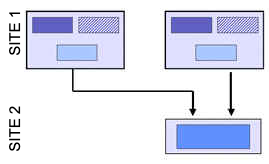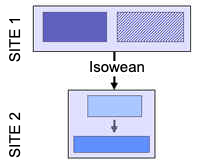A new proposed system for terms to use in describing the various one site and multi-site production systems that have evolved in the pork production industry, and a simplified system for diagraming various types of pig farms.
Note: This article is part one of a two-part series. The information it contains is an excerpt from the book "Multi-Site Pig Production" by Dr. Hank Harris, which is being published by Iowa State University Press. This information will also be published in the "Swine Practitioner" magazine. Pig333 thanks both publishers for the permission granted to publish the document on this website.

The concept of placing pig rearing systems on more than two locations was first introduced in 19881. Since that time many producers worldwide have constructed multi-site farms. A variety of terms have been utilized to describe these multi-site production systems. Some terms mean different things to different people and thus considerable confusion can occur. Furthermore, due to the variety of possible designs and layouts for pig farms, it is often difficult for owners, farm managers, veterinarians, service personnel, and lenders to communicate effectively with one another.
The objective of this paper is to acquaint the veterinary practitioner with terms recommended for describing one site and multi-site production systems. We also propose a simplified system for diagraming various types of pig farms.
Terminology
Stages of Production2 - The three stages of production are: 1) Breeding Production Stage; 2) Nursery Production Stage; and 3) Finisher Production Stage.
Stage 1- Breeding Production Stage2 Production stage in which breeding females and boars are kept and managed for the purpose of producing weaned pigs.
Stage 2- Nursery Production Stage2 Production stage associated with nursery pigs.
Stage 3- Finisher Production Stage2 Production stage associated with finisher pigs.
Site. A site number indicates the placement for the various stages of production. Pigs may be reared on one or more locations (loci) within a site.
Locus or Loci. Loci indicate the number of geographic locations for each stage of production at each site. There may be one or more buildings at each locus.
Single Locus. A stage of production is placed entirely on one geographic location.
Multi-Loci. A stage of production is placed on more than one geographic location.
Source of pigs. In Multi-Site Production, source refers to either the number of loci in stage 1 producing Isowean pigs, or the number of loci in stages 1 and 2 producing feeder pigs.
Single Source. The pigs originate from only one locus of stages 1 and 2.
Multi-Sources. The pigs originate from more than one locus of stages 1 and 2.

Isowean3. At weaning, piglets are placed in isolated accommodations. The term isowean was derived from the words isolated weaning. The purpose of Isowean is twofold: 1) elimination of infectious agents and 2) enhancement of growth rate and lean tissue deposition. Precautions are taken to assure that each group of Isowean pigs are not contaminated by other age groups of pigs. The weaning age is variable from 5 days up to 21-28 days of age depending upon the infections to be eliminated. Other terms that have been used for Isowean are modified Medicated Early Weaning (MMEW), segregated early weaning (SEW), segregated weaning, age segregated rearing (ASR), isolated weaning and segregated disease control (SDC).
| It is recommended that the term Isowean be used rather than MMEW, SEW, ASR or SDC. Early weaning is not necessary for the advantages of Isowean (isolated weaning) to be realized and thus the use of the word early is not recommended. The term segregated early weaning (SEW) was originated by Drs. Rodney Goodwin (NPPC) and the late Lauren Christian (ISU). The term Isowean could not be used by NPPC at that time because it had been registered as a trademark by PIC. Recently, PIC has removed all trademark restrictions from the use of the term Isowean. All pork producers and the general public may now use the term Isowean without trademark infringement. |
One site production
One-site (farrow-to-finish)- All 3 stages of production take place on site 1 in one locus. Historically, the traditional way pigs were raised.
Two site production
Traditional Two Site. Two site production when stages 1 and 2 are placed on site 1 at one or more loci and stage 3 is placed on site 2 at one or more loci. Prior to 1989, this was the only type of Two Site Production system. Isowean does not apply.
Two Site Isowean. Two site production when stage 1 is placed on site 1 at one or more loci and both stages 2 and 3 are placed on site 2 at one or more loci. Isowean is applied between sites 1 and 2.
NurFin Isowean. Each batch of weaned pigs is placed in a NurFin (wean to finish) building at site 2. Isowean is applied between sites 1 and 2.
Three Site Production
Three site. Each of the three stages of production are located on three separate sites; referred to as Sites 1, 2, and 3 respectively. Each stage of production may be on one or more loci within a site. Isowean is applied between sites 1 and 2.
Multi-Sources and Multi-Loci
The breeding production stage in traditional two site, two site isowean and three site farms may be on more than one loci within site 1 (originate from more than one source). In addition, these systems may place pigs in the nursery and finisher production stages on more than one locus within sites 2 and 3. Therefore, these terms are used to indicate whether pigs originate from either single or multi-sources in site 1 and if either single or multi-loci are utilized in sites 2 and 3.
Multi-Site Pig Production. A blanket term to cover any arrangement of sites and loci including all types of two and three site production systems. Isowean may or may not be applied.
Multi-Site Isowean Production. A blanket term to cover any arrangement of sites that incorporates the Isowean Principle including the various possible configurations for two and three site production. Isowean pigs may be from single or multiple sources. Also referred to as modern-day Multi-Site Production.
| In past publications, the term multiple site has been used to describe three site systems with multiple sources and/or loci. It is recommended that the use of the term multiple site be discontinued. Based on the above definitions of site and locus(i), the term multiple site does not clearly describe a swine rearing system. |
Examples
Please see the accompanying illustrations as examples of the following simplified terms and diagrams for one site and multi-site pig production systems.
|
|
|
One site production Stages of production 1, 2, and 3 are on one site 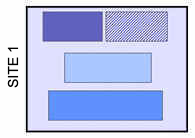
|
| Traditional two-site production Multi-source: Stages 1 and 2 are on more than one locus (multiple source feeder pigs) within site 1 Single locus: Stage 3 is on one locus within site 2 |
Two site Isowean production Single source: Stage 1 is on one locus within site 1 Single locus: stages 2 and 3 are on one locus within site 2 |
|
|
|
|
NurFin Isowean production Single source: Stage 1 is on one locus within site 1 |
Three site production Multi-source: Stage 1 production is on more than one loci within site 1; stage 2 is on more than one loci within site 2 |
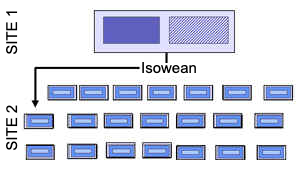 |
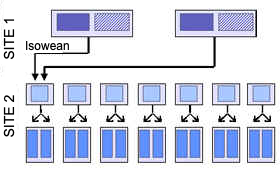 |
References
1. Harris, D.L. 1988. Vet Rec 123:422-423; Proc USAHA 416-426.
2. Terms recommended by Will Marsh, editor, National Pork Production and Financial Technical Manual published by the National Pork Producers Council, 1998.
3. Harris, D.L. 1990. Large An Vet 10-12; IPVS 11th congress:374.
4. Goodwin, R.N. and S. Burroughs . 1995. NPPC Terminal Sire Line National Genetic Evaluation Results. Des Moines, IA.



 Adults
Adults Nursery
Nursery Locus
Locus Adults + lactation
Adults + lactation Finishing
Finishing